
In Greek mythology, Silenus was a companion and tutor to the wine god Dionysus. He is typically older than the satyrs of the Dionysian retinue (thiasos), and sometimes considerably older, in which case he may be referred to as a Papposilenus. Silen and its plural sileni refer to the mythological figure as a type that is sometimes thought to be differentiated from a satyr by having the attributes of a horse rather than a goat, though usage of the two words is not consistent enough to permit a sharp distinction.
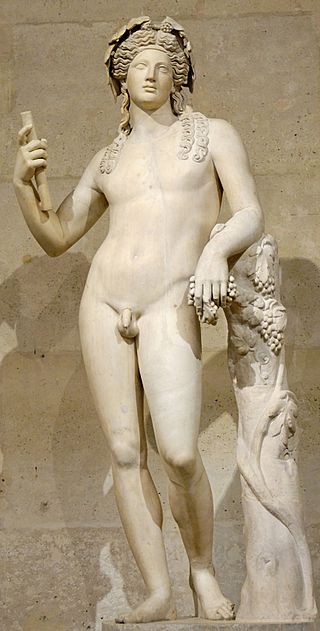
In ancient Greek religion and myth, Dionysus is the god of wine-making, orchards and fruit, vegetation, fertility, festivity, insanity, ritual madness, religious ecstasy, and theatre. He was also known as Bacchus by the Greeks for a frenzy he is said to induce called baccheia. As Dionysus Eleutherius, his wine, music, and ecstatic dance free his followers from self-conscious fear and care, and subvert the oppressive restraints of the powerful. His thyrsus, a fennel-stem sceptre, sometimes wound with ivy and dripping with honey, is both a beneficent wand and a weapon used to destroy those who oppose his cult and the freedoms he represents. Those who partake of his mysteries are believed to become possessed and empowered by the god himself.

Praxiteles of Athens, the son of Cephisodotus the Elder, was the most renowned of the Attica sculptors of the 4th century BC. He was the first to sculpt the nude female form in a life-size statue. While no indubitably attributable sculpture by Praxiteles is extant, numerous copies of his works have survived; several authors, including Pliny the Elder, wrote of his works; and coins engraved with silhouettes of his various famous statuary types from the period still exist.

In Ancient Greece a thyrsus or thyrsos was a wand or staff of giant fennel covered with ivy vines and leaves, sometimes wound with taeniae and topped with a pine cone, artichoke, fennel, or by a bunch of vine-leaves and grapes or ivy-leaves and berries, carried during Hellenic festivals and religious ceremonies. The thyrsus is typically associated with the Greek god Dionysus, and represents a symbol of prosperity, fertility, and hedonism similarly to Dionysus.
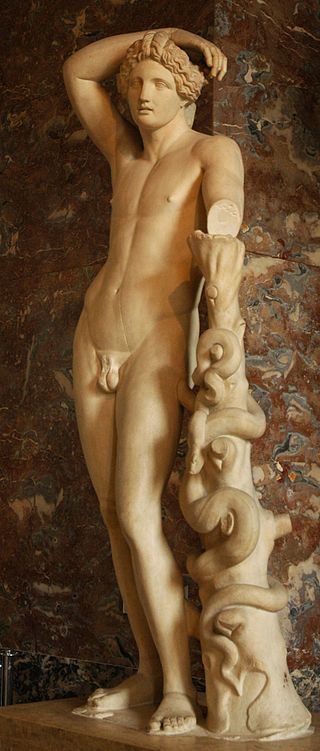
The Apollo Lyceus type, also known as Lycean Apollo, originating with Praxiteles and known from many full-size statue and figurine copies as well as from 1st century BCE Athenian coinage, is a statue type of Apollo showing the god resting on a support, his right forearm touching the top of his head and his hair fixed in braids on the top of a head in a haircut typical of childhood. It is called "Lycean" not after Lycia itself, but after its identification with a lost work described, though not attributed to a sculptor, by Lucian as being on show in the Lyceum, one of the gymnasia of Athens. According to Lucian, the god leaning on a support with his bow in his left hand and his right resting on his head is shown "as if resting after long effort." Its main exemplar is the Apollino in Florence or Apollo Medici, in the Uffizi, Florence.

The Dying Gaul, also called The Dying Galatian or The Dying Gladiator, is an ancient Roman marble semi-recumbent statue now in the Capitoline Museums in Rome. It is a copy of a now lost Greek sculpture from the Hellenistic period thought to have been made in bronze. The original may have been commissioned at some time between 230 and 220 BC by Attalus I of Pergamon to celebrate his victory over the Galatians, the Celtic or Gaulish people of parts of Anatolia. The original sculptor is believed to have been Epigonus, a court sculptor of the Attalid dynasty of Pergamon.

The life-size ancient but much restored marble statue known as the Barberini Faun, Fauno Barberini or Drunken Satyr is now in the Glyptothek in Munich, Germany. A faun is the Roman equivalent of a Greek satyr. In Greek mythology, satyrs were human-like male woodland spirits with several animal features, often a goat-like tail, hooves, ears, or horns. Satyrs attended Dionysus.

The Capitoline Museums are a group of art and archaeological museums in Piazza del Campidoglio, on top of the Capitoline Hill in Rome, Italy. The historic seats of the museums are Palazzo dei Conservatori and Palazzo Nuovo, facing on the central trapezoidal piazza in a plan conceived by Michelangelo in 1536 and executed over a period of more than 400 years.

The Ludovisi Ares is an Antonine Roman marble sculpture of Ares, a fine 2nd-century copy of a late 4th-century BCE Greek original, associated with Scopas or Lysippus: thus the Roman god of war receives his Greek name, Ares.

Bacchus (1496–1497) is a marble sculpture by the Italian High Renaissance sculptor, painter, architect and poet Michelangelo. The statue is somewhat over life-size and represents Bacchus, the Roman god of wine, in a reeling pose suggestive of drunkenness. Commissioned by Raffaele Riario, a high-ranking Cardinal and collector of antique sculpture, it was rejected by him and was bought instead by Jacopo Galli, Riario's banker and a friend to Michelangelo. Together with the Pietà, the Bacchus is one of only two surviving sculptures from the artist's first period in Rome.

The Gardens of Sallust was an ancient Roman estate including a landscaped pleasure garden developed by the historian Sallust in the 1st century BC. It occupied a large area in the northeastern sector of Rome, in what would become Region VI, between the Pincian and Quirinal hills, near the Via Salaria and later Porta Salaria. The modern rione is now known as Sallustiano.

The National Roman Museum is a museum, with several branches in separate buildings throughout the city of Rome, Italy. It shows exhibits from the pre- and early history of Rome, with a focus on archaeological findings from the period of Ancient Rome.
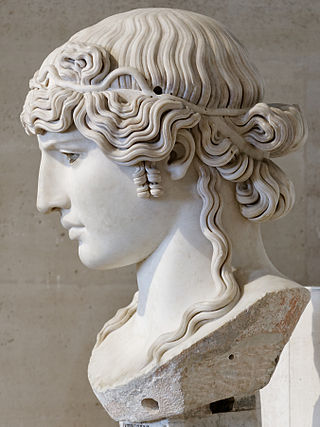
The Antinous Mondragone is a 0.95-metre high marble example of the Mondragone type of the deified Antinous. This colossal head was made sometime in the period between 130 AD to 138 AD and then is believed to have been rediscovered in the early 18th century, near the ruined Roman city, Tusculum. After its rediscovery, it was housed at the Villa Mondragone as a part of the Borghese collection, and in 1807, it was sold to Napoleon Bonaparte; it is now housed in the Louvre in Paris, France.

The Ludovisi Gaul is an ancient Roman statue depicting a Gallic man plunging a sword into his breast as he holds up the dying body of his wife. This sculpture is a marble copy of a now lost Greek bronze original. The Ludovisi Gaul can be found today in the Palazzo Altemps in Rome. This statue is unique for its time because it was common to depict the victor but instead, the Ludovisi Gaul depicts the defeated.

The Rape of Proserpina, more accurately translated as The Abduction of Proserpina, is a large Baroque marble group sculpture by Italian artist Gian Lorenzo Bernini, executed between 1621 and 1622, when Bernini's career was in its early stage. The group, finished when Bernini was just 23 years old, depicts the abduction of Proserpina, who is seized and taken to the underworld by the god Pluto. It features Pluto holding Proserpina aloft, and a Cerberus to symbolize the border into the underworld that Pluto carries Proserpina into.
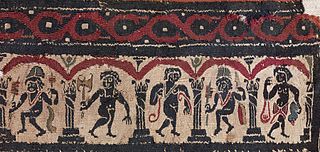
The cult of Dionysus was strongly associated with satyrs, centaurs, and sileni, and its characteristic symbols were the bull, the serpent, tigers/leopards, ivy, and wine. The Dionysia and Lenaia festivals in Athens were dedicated to Dionysus, as well as the phallic processions. Initiates worshipped him in the Dionysian Mysteries, which were comparable to and linked with the Orphic Mysteries, and may have influenced Gnosticism. Orpheus was said to have invented the Mysteries of Dionysus. It is possible that water divination was an important aspect of worship within the cult.

The Resting Satyr or Leaning Satyr, also known as the Satyr anapauomenos is a statue type generally attributed to the ancient Greek sculptor Praxiteles. Some 115 examples of the type are known, of which the best known is in the Capitoline Museums.
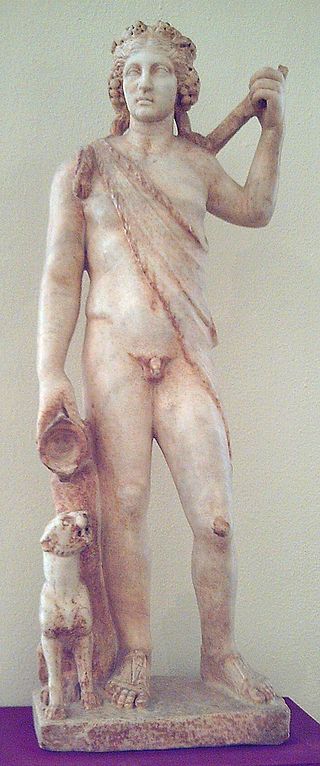
The Bacchus of Aldaia is a Roman marble statuette of the Roman god Bacchus (Dionysus) that was found in La Ereta dels Moros in Aldaia, Valencia, in Spain, in fragments between the years 1884 and 1924. The god is depicted naked except for a deer skin and wearing sandals and a floral crown. The sculpture is exhibited in the National Archaeological Museum of Spain in the capital Madrid.

The Palazzo Massimo alle Terme is the main of the four sites of the Roman National Museum, along with the original site of the Baths of Diocletian, which currently houses the epigraphic and protohistoric section, Palazzo Altemps, home to the Renaissance collections of ancient sculpture, and the Crypta Balbi, home to the early medieval collection.



















